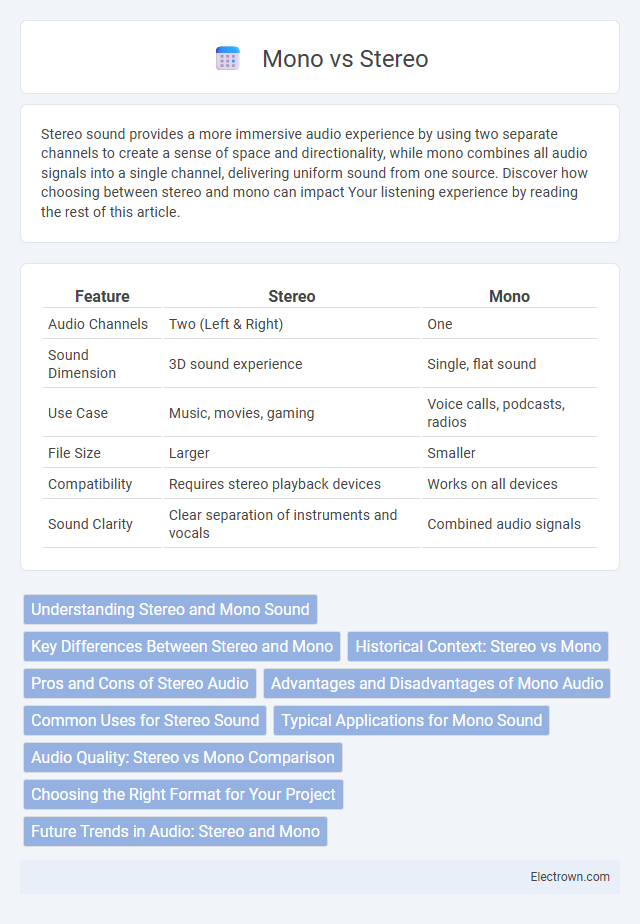Stereo sound provides a more immersive audio experience by using two separate channels to create a sense of space and directionality, while mono combines all audio signals into a single channel, delivering uniform sound from one source. Discover how choosing between stereo and mono can impact Your listening experience by reading the rest of this article.
Table of Comparison
| Feature | Stereo | Mono |
|---|---|---|
| Audio Channels | Two (Left & Right) | One |
| Sound Dimension | 3D sound experience | Single, flat sound |
| Use Case | Music, movies, gaming | Voice calls, podcasts, radios |
| File Size | Larger | Smaller |
| Compatibility | Requires stereo playback devices | Works on all devices |
| Sound Clarity | Clear separation of instruments and vocals | Combined audio signals |
Understanding Stereo and Mono Sound
Stereo sound delivers audio through two separate channels, creating a sense of spatial depth and direction that enhances your listening experience. Mono sound, on the other hand, combines all audio signals into a single channel, resulting in uniform sound regardless of speaker placement. Understanding stereo and mono sound is crucial for selecting the right audio setup based on your needs, whether for music production, broadcasting, or casual listening.
Key Differences Between Stereo and Mono
Stereo sound uses two separate audio channels to create a sense of spatial direction and depth, enhancing the listener's experience by simulating how humans naturally hear. Mono sound combines all audio signals into a single channel, resulting in one-source playback without directional cues, which ensures consistent sound quality across all playback devices. Understanding these key differences helps you choose the appropriate audio format for your project's needs, whether prioritizing immersive soundscapes or simplicity and compatibility.
Historical Context: Stereo vs Mono
Mono sound dominated early recording and broadcasting during the first half of the 20th century, with a single audio channel delivering a uniform listening experience. Stereo technology emerged prominently in the 1950s, offering two separate audio channels that created spatial depth, enhancing realism and immersion in music and film. Your understanding of these formats is crucial for appreciating how audio technology evolved from the simplicity of mono to the dynamic richness of stereo sound.
Pros and Cons of Stereo Audio
Stereo audio delivers a richer, more immersive sound experience by using two separate channels to create spatial effects, making music and movies feel more lifelike. However, stereo setups can be more complex and costly, requiring multiple speakers and precise positioning to achieve optimal sound quality. Your choice depends on whether you prioritize enhanced audio realism or simplicity and convenience in your listening environment.
Advantages and Disadvantages of Mono Audio
Mono audio delivers consistent sound quality across all listening devices by channeling audio into a single track, ensuring clarity and uniformity especially in environments with limited speaker setups. It reduces file size and complexity compared to stereo, making it ideal for voice recordings, podcasts, and telephony where spatial audio effects are unnecessary. However, mono lacks the immersive depth and directional cues provided by stereo sound, which can diminish the listening experience for music and multimedia requiring spatial awareness.
Common Uses for Stereo Sound
Stereo sound is commonly used in music production, film, and video games to create an immersive audio experience by delivering distinct left and right channel signals. This spatial separation enhances realism and allows listeners to perceive directionality and depth, making it ideal for concerts, home theaters, and virtual reality applications. Your entertainment system benefits from stereo sound by offering richer, more dynamic audio that closely mimics natural hearing.
Typical Applications for Mono Sound
Mono sound is commonly used in telephony systems, public address systems, and voice recordings where clarity and intelligibility are essential. Its single-channel output ensures consistent audio quality across all playback devices, making it ideal for podcasts and radio broadcasts. Your audio setup benefits from mono when precise sound localization is unnecessary, maximizing compatibility and reducing complexity.
Audio Quality: Stereo vs Mono Comparison
Stereo audio delivers a richer, more immersive sound experience by using two distinct channels to create spatial depth and precise instrument placement, enhancing audio quality. Mono combines all audio signals into a single channel, which can reduce clarity and the sense of space but ensures consistent sound across all playback devices. Your choice depends on whether you prioritize spatial audio fidelity (stereo) or uniform sound distribution (mono).
Choosing the Right Format for Your Project
Choosing between stereo and mono depends on the project's audio goals and environment; stereo provides spatial depth and directionality by separating audio into two channels, ideal for music, film, and immersive experiences. Mono combines all audio signals into a single channel, ensuring consistent sound quality across different playback systems, making it suitable for podcasts, voice-overs, and broadcasts. Consider audience listening devices and content type to optimize clarity and engagement in the final mix.
Future Trends in Audio: Stereo and Mono
Future trends in audio emphasize immersive experiences, driving the evolution of stereo sound with spatial audio technologies like Dolby Atmos and 3D audio, enhancing depth and directionality. Mono audio maintains relevance in streaming and voice-activated devices for bandwidth efficiency and clarity in speech-centric applications. Advances in AI-powered audio processing are expected to blur traditional distinctions, enabling dynamic switching between stereo and mono formats based on context and device capabilities.
stereo vs mono Infographic

 electrown.com
electrown.com